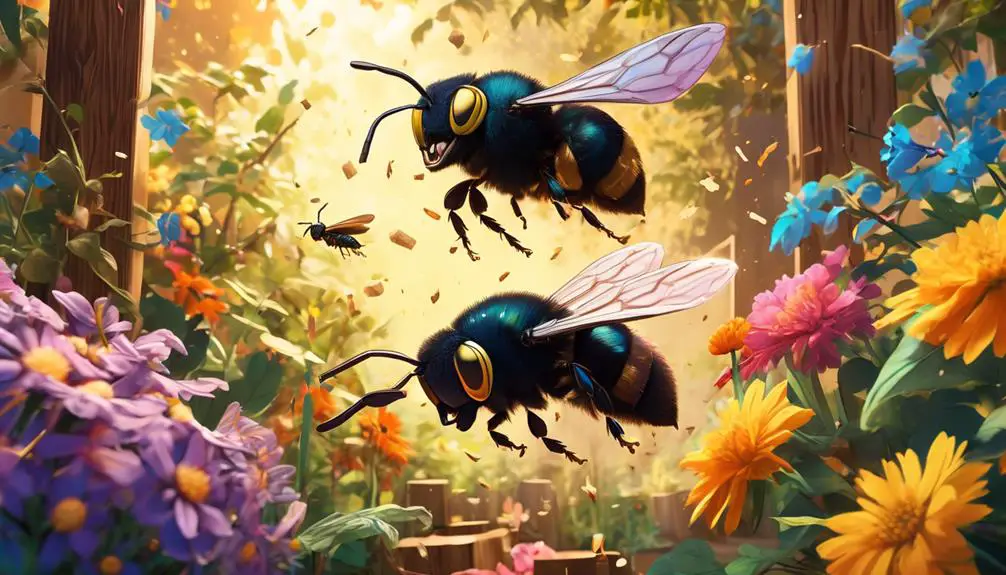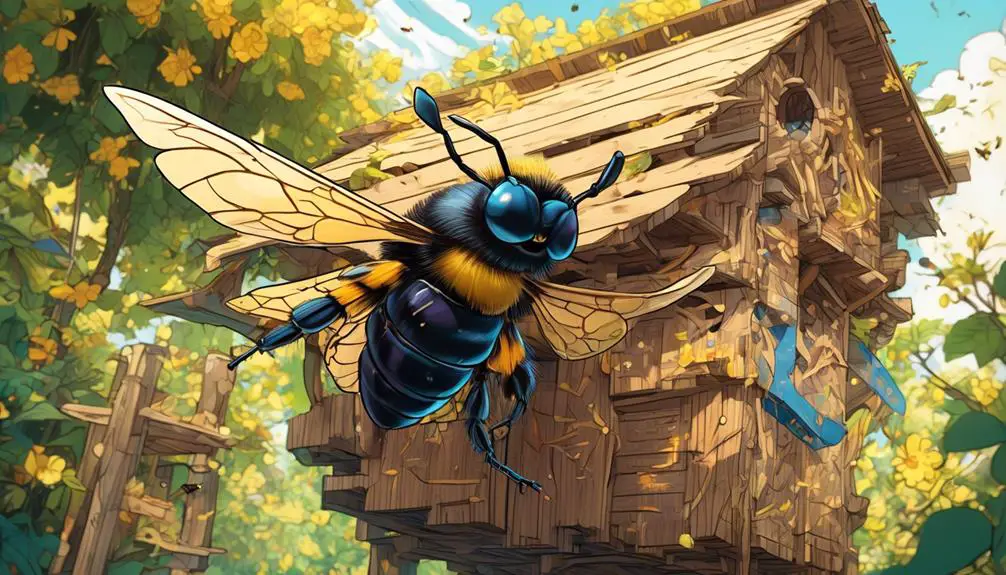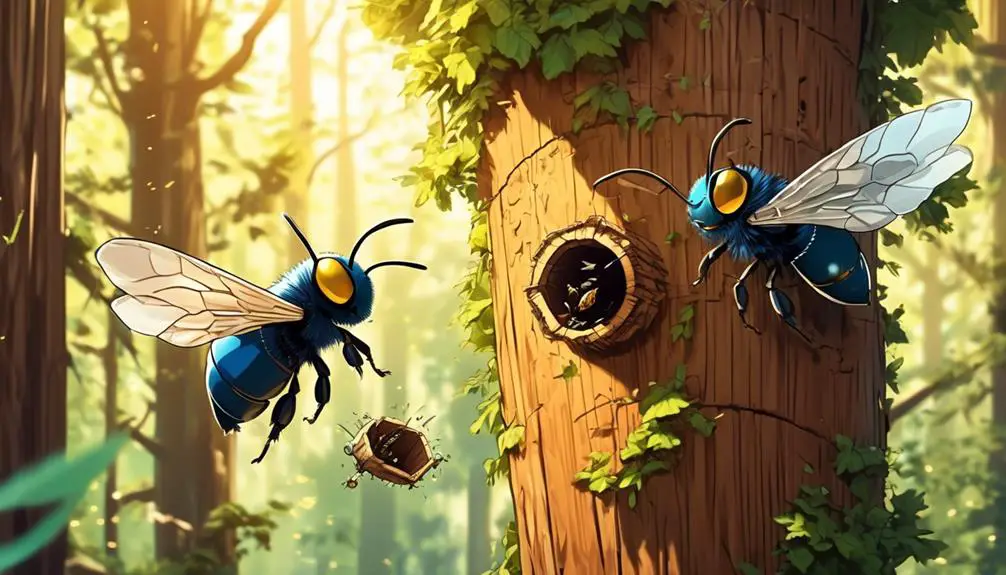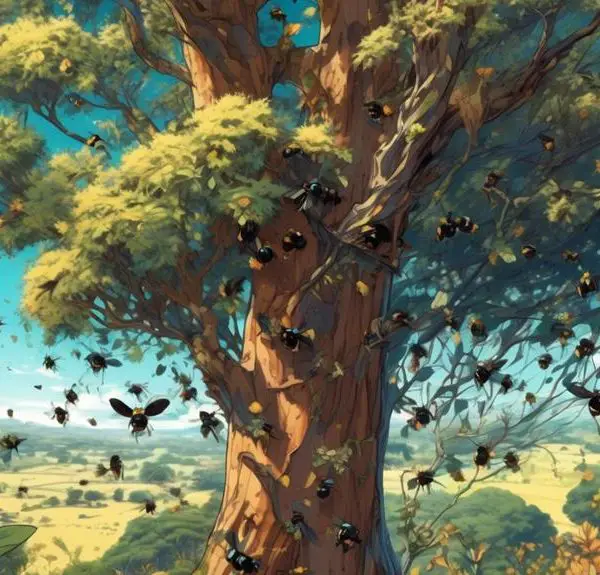Take a glimpse into the mesmerizing world of carpenter bees and their intricate aerial ballet of chase, a spectacle rich in mystery and complexity.

Carpenter Bees Chasing Each Other
Like dancers in a carefully choreographed ballet, carpenter bees often engage in an intriguing behavior: chasing each other. You've probably noticed these buzzing dynamos darting about your backyard, and maybe you've wondered what's going on. Are they playing? Competing? Communicating?
The answer isn't as simple as you might think. To fully grasp these complex interactions, you'll need to dive into the fascinating world of bee behavior and communication, a world that's as intricate and multifaceted as the bees themselves.
So, are you ready to pull back the curtain and uncover the mysteries behind these aerial acrobatics?
Key Takeaways
- Carpenter bees engage in playful chasing behavior to assert dominance and secure nesting sites.
- Male carpenter bees, despite being territorial, do not have stingers and pose no real threat.
- Carpenter bees exhibit sexual dimorphism, with males having a yellow face and females having a black face.
- Understanding carpenter bee flight patterns and communication can help interpret their behavior and colony dynamics.
Understanding Carpenter Bee Behavior

To fully grasp why carpenter bees chase each other, it's crucial to delve into their unique behavioral patterns and social structures. Unlike honey bees, which are social, carpenter bees are solitary creatures. The males are particularly territorial and will chase anything that poses a threat to their territory, including other males.
You might notice a carpenter bee hovering near wood surfaces around your home, as they're known to burrow into wood to lay their eggs. During this time, it's common to see males chasing each other, attempting to assert dominance and secure the best nesting sites.
Yet, it's also important to note that these bees aren't just aggressive. They're also curious creatures. Their chase is often engaging, almost playful. They'll chase and hover around anything large that moves, including you. Don't worry, though. The males, while territorial, don't have stingers and pose no real threat.
The Mating Habits of Carpenter Bees

Diving into the mating habits of carpenter bees, you'll find it's a fascinating blend of territorial confrontations and delicate courtship rituals. These insects exhibit distinct sexual dimorphism. Males, you'll notice, have a yellow face, while females' faces are black. Here's an interesting fact: males can't sting, but females can!
During mating season, males are fiercely territorial. They'll occupy and patrol a specific area, chasing away rival males. You'd think they're protecting a nest, but no. The males are actually laying claim to a space they believe will attract females. It's a captivating display of dominance and competition in the insect world.
When a female enters a male's territory, the male will perform an intricate courtship display, which includes hover flights and fast, zig-zag movements. If she's impressed, she'll mate with him.
After mating, the female will lay her eggs in a wooden tunnel she's chewed out herself. She'll then seal each egg in its own chamber with a mixture of chewed wood and her own feces.
In essence, the mating habits of carpenter bees are a complex dance of aggression, courtship, and careful maternal preparation.
Interpreting Carpenter Bee Flight Patterns

Understanding the flight patterns of carpenter bees can offer intriguing insights into their behavior and communication methods. You'll notice their movements aren't random but rather a complex system of signs.
Let's examine three common flight patterns:
Pattern | Description | Interpretation |
|---|---|---|
Circular | Buzzing in circles at high speed | Often a territorial display |
Hovering | Stationary flight with rapid wing movement | Signifies interest in a potential nest site |
Chasing | Pursuit of another bee | Typically a mating behavior |
When you see a carpenter bee buzzing in circles, it's likely marking its territory. This is an essential behavior to secure food resources and potential mating partners. Hovering, on the other hand, indicates that the bee has found a potential site for nesting. It's inspecting the area before making a commitment. Lastly, chasing is a clear sign of mating behavior. A male carpenter bee chases a female to show interest, and if she accepts his pursuit, they'll mate.
Through careful observation and interpretation, you can delve into the fascinating world of these bees, gaining a deeper understanding of their intricate communication. Remember, it's not simply chaotic buzzing, it's a language of flight.
Carpenter Bee Colony Dynamics

Often overlooked, the dynamics of a carpenter bee colony reveal an intricate system of cooperation and competition, crucial for survival and reproduction. You might be surprised to learn that unlike honey bees, carpenter bees are primarily solitary. However, they do exhibit a fascinating form of social behavior known as 'communal nesting.'
While each female bee digs her own nest and lays her eggs, multiple females may share a common entrance or even parts of the same tunnel. This cohabitation allows for shared defense against predators and parasites, and it's here that you'll often see the intriguing behavior of bees chasing each other.
Yet, it's not all peace and cooperation. Competition arises when females attempt to 'steal' nests from each other. This behavior, known as usurpation, involves an invading bee fighting with a nest owner until one concedes defeat. The victor then takes over the nest, laying her eggs and ensuring her genes continue.
Understanding these dynamics can help in managing carpenter bees, particularly if they're causing damage to wooden structures. Remember, they're not just pests – they're part of an intricate, fascinating biological system.
The Role of Chasing in Bee Communication

In the world of carpenter bees, you'll find that chasing plays a pivotal role in their complex communication system. The act of chasing, not just a random flight pattern, is a calculated behavior used for various purposes.
Chasing Behavior | Purpose |
|---|---|
Repetitive Circling | Mating Ritual |
Swift Zigzags | Territorial Defense |
Hovering Follow | Warning Signal |
Rapid Darting | Food Location Indication |
Sudden Dive | Predator Alert |
You'll notice that the behaviors differ, each with a distinct purpose. Repetitive circling, for instance, is a unique mating ritual, while swift zigzags are used for territorial defense. Similarly, a hovering follow serves as a warning signal to other bees, whereas rapid darting indicates the location of a food source. Lastly, a sudden dive is used to alert others of a looming predator.
Analyzing these behaviors, it's evident that chasing is not solely about pursuit. It's an intricate part of carpenter bee communication, used to convey critical information. Understanding this can provide valuable insight into the social structure and survival strategies of these fascinating insects.
Conclusion
So, you've observed carpenter bees chasing each other. This isn't just frivolous play. It's a complex interplay of mating rituals, colony dynamics, and communication.
The way these bees zigzag, hover, and chase is more than just flight; it's a language. Bees tell stories in the sky, interwoven with the biological imperative to reproduce, maintain their colony, and communicate.
Understanding these intricate patterns brings us closer to appreciating the nuanced lives of these fascinating creatures.



